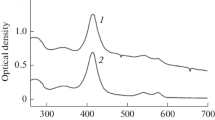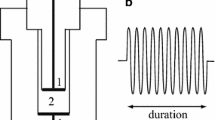Summary
A method of preparing hemoglobin-depleted resealed ghosts with an extremely low hemoglobin content is described. The membrane morphology, the crossed immunoelectrophoresis pattern of the membrane proteins, and the transport function of these ghosts have been examined.
Electron microscopic examination of the ghosts on hydrophilic as well as hydrophobic grid surfaces revealed a faint filamentous network (spectrin) associated with the membrane. The ghosts were found to have permeabilities towards small polar molecules (water and mannitol) and ions (chloride, sodium, and potassium) which are quantitatively very close to those of intact red cells.
It is concluded that white ghosts prepared by the present method are well suited for simultaneous studies of morphology, membrane biochemistry, and membrane transport functions.
Similar content being viewed by others
References
Bjerrum, O.J., Bøg-Hansen, T.C. 1976. The immunochemical approach to the characterization of membrane proteins.Biochim. Biophys. Acta 455:66
Bjerrum, O.J., Lundahl, P. 1974. Crossed immunoelectrophoresis of human erythrocyte membrane proteins.Biochim. Biophys. Acta 342:69
Bjerrum, P.J., Tranum-Jensen, J. 1977. Erythrocyte membrane, spectrin morphology and membrane permeability at normal and low pH values. Proceedings of the International Union of Physiological Science. Vol. XIII p. 80. (Paris, 1977)
Bodemann, H., Passow, H. 1972. Factors controlling the reaseling of the membrane of human erythrocyte ghosts after hypotonic hemolysis.J. Membrane Biol. 8:1
Bowmann, R.J., Levitt, D.G. 1977. Polyol permeability of the human red cell: Interpretation of glucose transport in terms of a pore.Biochim. Biophys. Acta 466:68
Brahm, J. 1977. Temperature-dependent changes of chloride transport in human red cells.J. Gen. Physiol. 70:283
Brecher, G., Jacobek, E.F., Schneiderman, M.A. 1962. Size distribution of erythrocytes. Ann. N.Y. Acad. Sci.99:242
Cabantchik, Z.I., Rothstein, A. 1974. Membrane proteins related to anion permeability of human red cell.J. Membrane Biol. 15:207
Cass, A., Finkelstein, A. 1967. Water permeability of thin lipid membranes.J. Gen. Physiol. 50:1765
Dalmark, M., Wieth, J.O. 1972. Temperature dependence of chloride, bromide, iodide, thiocyanate and salicylate transport in human red cells.J. Physiol. (London) 224:583
Dodge, J.T., Mitchell, C., Hanahan, D.J. 1963. The preparation and chemical characterization or hemoglobin-free ghosts of human erythrocytes.Arch. Biochim. Biophys. 100:119
Funder, J., Tosteson, D.C., Wieth, J.O. 1978. Effects of bicarbonate on lithium transport in human red cellsJ. Gen. Physiol. 71:721
Funder, J., Wieth, J.O. 1966. Determination of sodium, potassium and water in human red blood cells.Scand. J. Clin. Lab. Invest. 18:151
Funder, J., Wieth, J.O. 1967. Effects of ouabain on glucose metabolism and on fluxes of sodium and potassium of human blood cells.Acta Physiol. Scand. 71:113
Funder, J., Wieth, J.O. 1976. Chloride transport in human erythrocytes and ghosts: A quantitative comparison.J. Physiol. (London) 262:679
Gardos, G. 1958. The function of calcium in the potassium permeability of human erythrocytes.Biochim. Biophys. Acta 30:653
Gunn, R.B., Dalmark, M., Tosteson, D.C., Wieth, J.O. 1973. Characteristics of chloride transport in human red blood cells.J. Gen. Physiol. 61:185
Gunn, R.B., Wieth, J.O., Tosteson, D.C. 1975. Some effects of low pH on chloride exchange in human red blood cells.J. Gen. Physiol. 65:731
Hainfield, J.F. and Steck, T.L. 1977. The sub-membrane reticulum of the human erythrocyte: A scanning electron microscope study.J. Supramol. Struct. 6:301
Hazlewood, C.F., Beall, P.T., Singer, D. 1978. Electron microscopic examinations of human red blood cell “ghost” preparations.Fed. Proc. 37:313
Helenius, A., Simons, K. 1975. Solubilization of membranes by detergents.Biochim. Biophys. Acta 415:29
Hillier, J., Hoffman, J.F. 1953. On the ultrastructure of the plasma membrane as determined by the electron microscope.J. Cell Comp. Physiol. 42:203
Hoogeveen, J.T., Juliano, R., Coleman, J., Rothstein, A. 1970. Water-soluble proteins of the human red cell membrane.J. Membrane Biol. 3:156
Johnson, R.M. 1975. The kinetics of resealing of washed erythrocyte ghosts.J. Membrane Biol. 22:231
Jung, C.Y. 1971. Evidence of high stability of the glucose transport carrier function in human red cell ghosts extensively washed in various media.Arch. Biochem. Biophys. 146:215
Lepke, S., Fasold, H., Pring, M., Passow, H. 1976. A study of the relationship between inhibition of anion exchange and binding to red blood cell membrane of 4.4′-diisothiocyano stilbene-2.2′-disulfonic acid (DIDS) and its dihydro derivative (H2DIDS).J. Membrane Biol. 29:147
Macey, R.I., Karan, D.M., Farmer, R.E.L. 1972. Properties of water channels in human red cells.In: Biomembranes. Vol. 3, pp. 331–340. F. Kreuzer and J.F.G. Slegers, editors. Plenum Press, New York
Norrild, B., Bjerrum, O.J., Vestergaard, B.F. 1977. Polypeptide analysis of individual immunoprecipitates from crossed immunoelectrophoresis.Anal. Biochem. 81:432
Rostgaard, J., Christensen, P. 1975. A multipurpose specimen-carrier for handling small biological objects through critical point drying.J. Microsc. 105:107
Schwoch, G., Passow, H. 1973. Preparation and properties of human erythrocyte ghosts.Molec. Cell. Biochem. 2:197
Ship, S., Shami, Y., Breuer, W., Rothstein, A. 1977. Synthesis of tritiated 4,4′-diisothiocyano-2.2′ stilbene disulfonic acid ([3H]DIDS) and its covalent reaction with sites related to anion transport in human red blood cells.J. Membrane Biol. 33:311
Steck, T.L. 1974. The organization of proteins in the human red blood cell membrane.J. Cell Biol. 62:1
Weed, R.I., Reed, C.F., Berg, G. 1963. Is hemoglobin an essential structural component of human erythrocyte membranes.J. Clin. Invest. 42:581
Weeke, B. 1973. General remarks on principles equipment, reagents and procedures.Scand. J. Immunol. (2 suppl.)1:15
Westerman, M.P., Pierce, L.E., Jensen, W.N. 1961. A direct method for the quantitative measurement of red cell dimensions.J. Lab. Clin. Med. 57:819
Zaki, L., Fasold, H., Schuhmann, B., Passow, H. 1975. Chemical Modification of membrane proteins in relation to inhibition of anion exchange in human red blood cells.J. Cell. Physiol. 86:471
Author information
Authors and Affiliations
Rights and permissions
About this article
Cite this article
Bjerrum, P.J. Hemoglobin-depleted human erythrocyte ghosts: Characterization of morphology and transport functions. J. Membrain Biol. 48, 43–67 (1979). https://doi.org/10.1007/BF01869256
Received:
Revised:
Issue Date:
DOI: https://doi.org/10.1007/BF01869256




